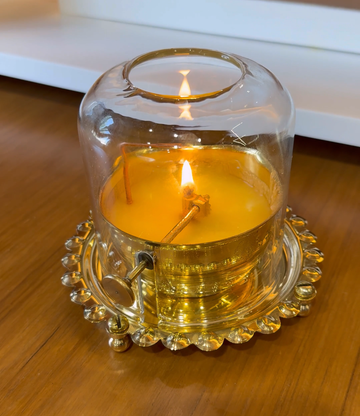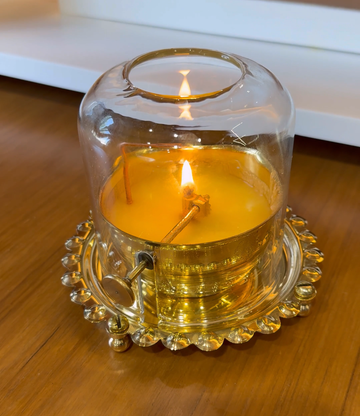The Akhand Jyot Diya, or eternal flame, has a revered place in Hinduism. Its persistent glow represents unwavering faith, divine benedictions, and the triumph of light over darkness. Going beyond its spiritual significance, the Akhand Diya also signifies profound cultural and environmental meaning.
In this blog, we discover how the Akhand Diya is an eternally iconic symbol of light, tradition, and sustainability.
1. Symbol of Divine Presence and Light
The Akhand Diya symbolizes the constant divine energy in our lives. Its unbroken flame is a strong symbol of hope, purity, and spiritual awakening. In most Hindu homes, lighting an Akhand Diya is a sign of connection to the divine and a means to welcome blessings into the home.
Used during festivals such as Navratri and Diwali or for everyday worship, the flame of the diya symbolizes the spiritual path to inner peace and truth.
2. Cultural and Traditional Importance
The tradition of igniting an Akhand Diya is deep within Hindu puja and celebrations. The diya is made to burn for the whole course of the festival, especially in those like Navratri, as a testament to the religious adherence to the deities.
That the flame doesn't end in the diya symbolizes how the devout always remain loyal to their gods and goddesses. In marriages, house-warming ceremonies, and pujas, an Akhand Diya is used as a promise to bring happiness, peace, and safety from all evil spirits.
3. Sustainability and Eco-Friendliness
Akhand Diya also encourages eco-friendly practices by using natural resources. Akhand jyot diyas can be made of clay, which is a biodegradable, eco-friendly, and centuries-old material that has been used to create diyas.
Ghee or mustard oil, which are usually consumed as fuel, are natural, renewable resources that emit no harmful fumes. In the current world where eco-awareness is vital, the use of Akhand Diyas is an easy and efficient means of going green.
4. Mindfulness and Meditation
The constant, peaceful flame of the Akhand Jyot Brass Diya can be used as a meditation and mindfulness focus point, too. Simply observing the flame to burn brings calmness of mind, tension reduction, and concentration.
It is not just a strengthening of one's inner spiritual bond through this meditating process but it also helps increase mental clarity and peace of heart. The procedure of keeping the flame of the diya in itself becomes an act of mindfulness, inviting perseverance and commitment.
5. Family and Community Bonding
The burning of an Akhand Diya is usually a family or community affair. Family members take turns to keep the light burning during festivals, creating a bond of unity and shared responsibility.
In larger community gatherings, the Akhand Jyot Diya serves as a representation of the collective devotion of the people and a symbol of cultural heritage, and people get together to celebrate common beliefs and practices.
6. Contemporary Adaptations
Though traditional Akhand Diyas continue to enjoy popularity, innovative developments have also found their place in homes. Brass and glass-covered Akhand Diyas have become the norm, providing shelter from wind and a longer burning flame. These modifications preserve the diya's spiritual significance without compromising on modern-day lifestyles.
Conclusion
The Akhand Diya is not just a ritualistic item; it is a representation of persistent faith, cultural heritage, and environmental awareness. Its eternal flame remains the beacon that shines in lives, leading devotees on the path of spiritual ascension and enabling a profound bond with tradition.
By including the Akhand Diya in our day-to-day prayers and festivities, we not only pay homage to our heritage but also adopt an eco-friendly and conscious mode of living. May its ever-lasting flame be the guiding star to peace, prosperity, and illumination for generations to come.





